
Factors to Consider When Buying a Yoga Mat
Choosing the right yoga mat for your practice is crucial in helping you get the most out of your flows. With different sizes, materials, textures, and thicknesses to consider, it can be overwhelming trying to decide which yoga mat is best suited for your needs. This comprehensive guide covers all the key factors to keep in mind when shopping for the ideal yoga mat.
Thickness
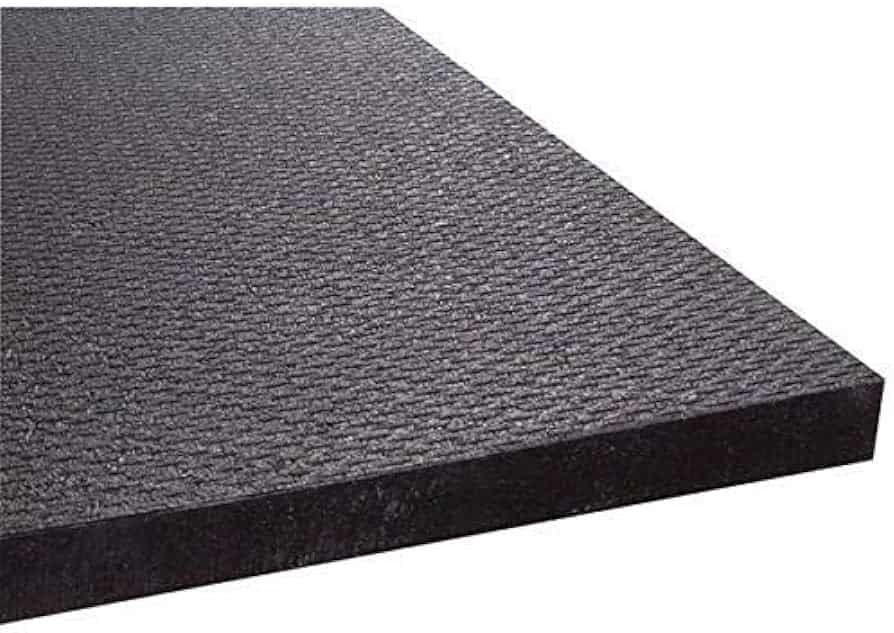
One of the most important factors when selecting a yoga mat is thickness. Standard yoga mats tend to be around 1/8 inch thick, while thicker mats can range from 1/4 inch to 1/2 inch thick. Thicker mats provide more cushioning and support, which can make certain poses more comfortable. They are especially beneficial if you have sensitive joints or prefer more padding under your body. For example, when kneeling during seated poses, a thick mat creates a comfortable barrier between your joints and the floor. Thicker mats are also indispensable for restorative practices where you remain stationary for longer periods.
However, thicker yoga mats also weigh more. A 1/2-inch mat can weigh 7-8 pounds, making it less convenient to transport to and from the yoga studio. If portability and ease of carrying are a priority, you may prefer keeping things lightweight with a more travel-friendly thin mat in the 1/8-inch range. You can always supplement with extra blankets, towels, or yoga blocks during practice to create makeshift padding. read more
Materials
Common materials used to create yoga mats include PVC, rubber, cotton, microfiber, and more specialty materials like recycled polymer and PER. Consider the pros and cons of each yoga mat fabric when determining the best material type for your individual needs:
Rubber Mats
Rubber yoga mat have a responsive, resilient feel underfoot and are easy to keep clean. The rubber effectively prevents sliding on hardwood floors and won’t absorb sweat or moisture during hot yoga flows. Natural tree rubber is also sustainably sourced, unlike synthetic plastics which are petroleum-based. However, the natural rubber smell may take several weeks to fade completely. Leaving your new rubber mat unrolled can help release the odor more quickly.
PVC Mats
PVC (polyvinyl chloride) mats provide excellent non-slip grip performance and a smooth, soft surface for practicing poses even during sweaty practices. They conform to the body well in prone poses like plank and tend to be inexpensive and lightweight too. However, PVC contains phthalates and will eventually wear down and need replacing as the material decomposes, making it less eco-friendly.
Cotton Mats
For those who prefer natural, biodegradable materials, cotton yoga mats provide a non-toxic surface for exercise. Cotton has an absorbent quality that makes it grippier when wet with sweat, unlike slippery PVC. However, this moisture-wicking quality can also lead to cotton mats retaining odors over time without proper cleaning. Cotton also compresses more thinly than denser rubber and synthetic mats, providing less cushioning. Using a towel on top can enhance grip and comfort.
Microfiber Mats
Travel-friendly microfiber mats fold up tightly while still providing dense foam padding for your joints during practice. They make great lightweight fitness mats for travel, especially for yin yoga which doesn’t require as much cushioning. However, microfiber tends to wear down more quickly under daily use for fast-paced styles like vinyasa flow. Spot cleaning right after use can prolong the life of your microfiber yoga companion.
Specialty & Recycled Materials
Eco-friendly yoga mat brands are offering innovative materials like PER (Polymer Environmental Resin) which provides a non-toxic PVC alternative or TPE (Thermoplastic Elastomer). These modern yoga mat materials are derived from renewable plant-based ingredients making them biodegradable. There are also great mat options made from recycled materials like sustainably harvested natural tree rubber, cork or recycled plastics and cotton.
Texture
The texture and feel of your yoga mat surface is another important element. Some people prefer more cushiony, fabric-like textures which can provide better grip with moisture. Others like the smooth yet non-slip feel of rubber with its denser impact absorption. Most high-quality yoga mats will indicate if they have a sticky, tacky grip texture or a smoother finish. Testing different textures firsthand can help determine your ideal yoga mat fabric.
Size
Standard sizes for yoga mats tend to be 24 inches wide and anywhere from 60 to 80 inches long (or approx 68 inches for average height). Those who are taller may want to size up to an extra long 84+ inch mat to ensure fully covering their frame in poses. If you take a lot of twisting poses, having those extra few inches in width allows your hands and feet to stay stacked on the mat without sliding off the edges. You can also consider carrying a small towel to lay perpendicular during twists for added sticky traction.
Portability
If you primarily practice at home, a heavier, bulkier mat may not pose any issues. But for yogis on the move, choosing a lightweight, low-profile mat that’s easy to roll up and transport can make all the difference in keeping up a consistent practice. Many mats now come with stretchy straps or buckles specifically designed to securely attach to the outside of your yoga mat when rolled up. Some brands like Manduka even make coordinating yoga mat bags with shoulder straps or backpack straps for easy carrying.
Types of Yoga Mats:
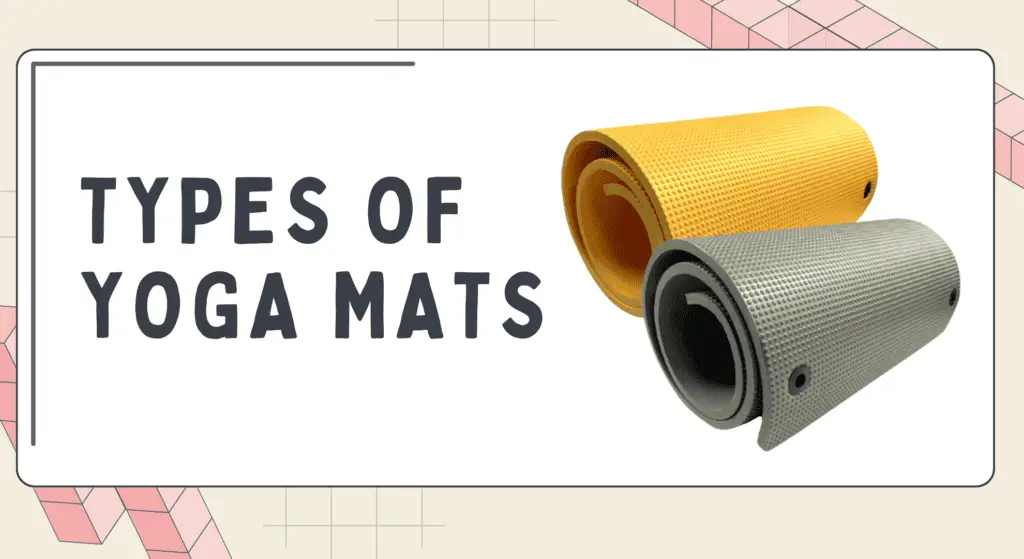
Now that you know which features to look for in a mat, let’s explore the common yoga mat categories and styles available:
Standard Yoga Mats
These average 1/8-inch thick mats represent the most basic and affordable yoga mat option for all needs. They provide a baseline of padding and traction without extra bulk. Standard mats work well as introductory models for beginners before investing in a more specialized thick mat. They also serve as great multi-purpose fitness mats for home workouts in addition to yoga flows.
Extra Thick Yoga Mats
Extra thick yoga mats measuring 1/4-inch to 1/2-inch thick offer the ultimate surface for joint protection and cushioning. The added thickness makes balance poses like the crow pose less painful on sensitive wrists. And poses done on your back and knees are more comfortable over long periods. Look for dense materials like natural rubber that provide support and stability in addition to plush padding. The trade-off tends to be increased weight and lower portability.
Travel Yoga Mats
Frequent travelers who don’t want to sacrifice their practice while on summer holidays or mid-business trips will appreciate the convenience of a travel yoga mat. These ultra-slim folding mats provide ample padding in a transportable form. They tend to be thinner with high-density foam layers that roll or fold down small enough to pack into a carry-on-sized backpack or piece of luggage. Having a removable strap also helps secure the yoga mat during transit without unrolling.
Hot Yoga Mats
Sweatier practices like Bikram and hot yoga require moisture-wicking yoga mats to prevent slipping. The best hot yoga mats feature open-cell materials like natural tree rubber or microfiber which absorb dampness while still maintaining tacky grip throughout your flow. Avoid using mats with impermeable surfaces like PVC that will simply get wet and slippery as sweat drips. Having a removable microfiber towel to layer on top also protects from moisture damage over time during intense heated vinyasa sessions.
Kids Yoga Mats
Sharing yoga with children provides tons of developmental and behavioral benefits associated with mind-body movement. But for kids’ yoga classes, an appropriately sized children’s mat helps build confidence in poses through early ages 6+. Look for fun colors/prints and shorter lengths around 50 inches. Thicker 1/4-inch mats provide ample cushioning for tender joints on hard floors. Finding kid’s yoga mat/bag combos allows easy transport between home and the studio.
Prenatal Yoga Mats
Pregnant yogis welcome the extra thickness and width of prenatal yoga mats designed to support their changing bodies. At least 1/4 inch and 68 inches long, they provide the ideal surface for comfort in floor poses through all trimesters. The wider width gives needed space for your knees, elbows, and belly while sideways. They make excellent postpartum mats too while rebuilding core strength. Consider a complimentary maternity fitness ball to aid with balance, hip opening, and strength.
Yoga Mat Features and Accessories:

Beyond the basic mat, there are a number of additional yoga gear add-ons that can enhance comfort, convenience and functionality:
Carrying Strap
Attached via durable stitched slots or metal grommets, an integrated carrying strap allows you to easily roll up and transport your yoga mat on the go. Adjustable straps can be customized to your desired length and worn cross-body style. Or choose a strap with padding for reduced strain on shoulders bearing longer walks from car to studio.
Absorption Layer
Some mat brands offer a separate microfiber towel layer that serves as both a sweat-absorbing cover and an anti-slip surface. Having a multi-
Here is the continued section on yoga mat features and accessories:
Absorption Layer
Some mat brands offer a separate microfiber towel layer that serves as both a sweat-absorbing cover and an anti-slip surface. Having a multi-purpose absorption layer prevents moisture from saturating into your mat foam over time. It also eliminates the need for a separate beach-sized towel. Choose an absorbent yoga mat towel made from quick-drying antimicrobial microfiber for longevity.
Alignment Marks
For newer yogis still learning precise hand and foot placement, choose a yoga mat printed with alignment markers along the perimeter. These non-slip cues provide visual guidance on centering limbs and distributing weight evenly during foundational poses. Some mats also include straight lines across the width, allowing you to ensure hands stack directly under shoulders in plank and low pushup variations.
Antimicrobial Treatment
fitness gear takes a beating from sweat, body oils, and bacteria accumulating in the foam layers. Choosing a yoga mat treated with antimicrobial silver ions or other microbial-resistant substances helps fend off mildew, mold, and odors over months of use. Proper cleaning is still required of any yoga mat, but antimicrobial properties provide helpful defense against deterioration.
Dry Grip Technology
Even without heating up a room, steady flows produce copious sweat dripping throughout practice. Mats claiming extra dry grip use proprietary technologies to maintain traction by actively repelling moisture from the surface foam. This prevents slippery sliding and allows secure footing in balancing postures regardless of sweat production. Dry grip mats utilize texture and materials strategically engineered to improve wet and dry traction.
Eco-Friendly Materials
Conscious consumers gladly welcome yoga mat options made from recycled or biodegradable materials like organic cotton, cork, PER, and tree rubber. Not only do eco-friendly mats appeal to the environmentally-minded yogi, but they also provide comparable quality and performance versus standard PVC options. Natural tree rubber in particular offers excellent durability and cushioning to support years of vigorous vinyasa while remaining compositionally akin to its outdoor origins.
Eco-Friendly Yoga Mat Materials
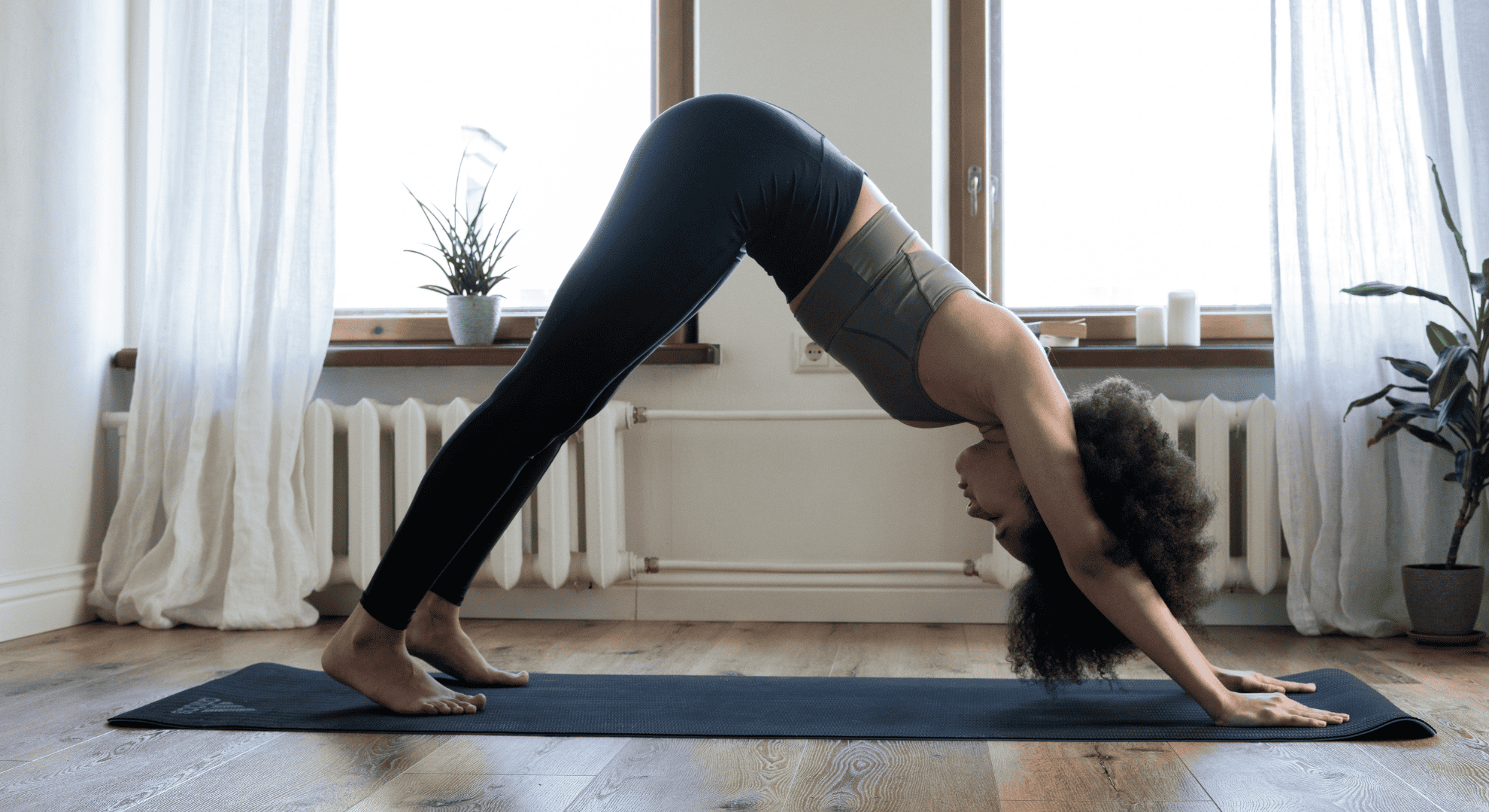
For those dedicated to green living from workout gear to cleaning products, opting for an eco-friendly yoga mat is the obvious choice. These innovative mat materials help lighten your environmental footprint without sacrificing performance:
Recycled Plastic
Mats constructed using post-consumer recycled plastic bottles divert waste from landfills while outputting a durable, supportive foam panel. Printing alignment cues directly into the mat surface also eliminates waste from manufacturing external marking products. Popular budget-friendly mat company Tumaz emphasizes recycled materials along with donating used goods to those displaced by natural disasters worldwide.
Tree Rubber
Sourced from renewable rubber trees, all-natural tree rubber yoga mats represent the gold standard in sustainable exercise equipment. Completely biodegradable and vegan-friendly, tree rubber provides the ideal balance of shock absorption, responsiveness and grip across styles from hot yoga to pilates. Leading eco-mat brand JadeYoga utilizes harvested natural rubber tapped straight from the Hevea Brasiliensis tree.
Organic Cotton
For the ultimate pure yogi experience, organically grown cotton yoga mats avoid any synthetic chemicals from farm to factory. GOTS (Global Organic Textile Standard) certified brands like Root2Rise adhere to strict oversight across the entire sustainable supply chain. Organic cotton biodegrades rapidly compared to synthetic mat materials. Top off your au naturel practice by spraying with organic essential oils.
TPE & PER
Eco-minded yoga accessories company Yogi Bare formulates their mats using premium TPE (Thermoplastic Elastomer) material rather than PVC. Derived from polyurethane, TPE repels moisture like traditional polymer mats but remains phthalate-free and 100% biodegradable. PER (Polymer Environmental Resin) offers another non-toxic PVC alternative gaining traction thanks to manufacturing advances.
Care and Cleaning of Yoga Mats
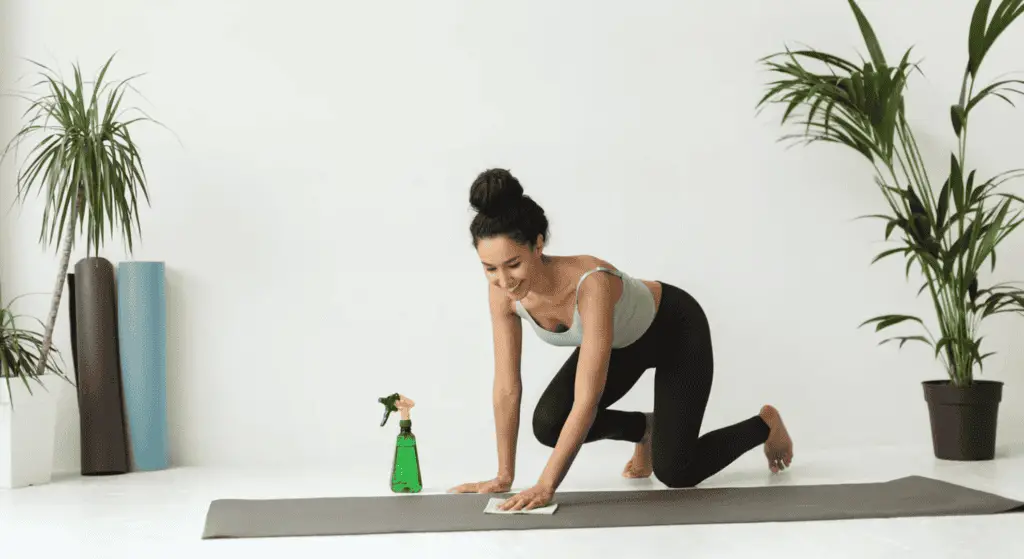
With repeated downward dogs and a pool of sweat in your practice space, your yoga mat will inevitably require regular cleaning. Consider monthly maintenance non-negotiable for every yogi. Follow these care guidelines to preserve the quality and lifespan of your trusty mat:
After Each Use
Get in the habit of allowing your yoga mat to completely air dry after class or home practice before rolling up. Give sweat, oils, and moisture time to evaporate versus trapping it within the rolled folds where bacteria spread quickly. You can place the mat over two chairs to keep it flat and off the floor while drying for quicker ventilation.
Also shake out any dirt, hair, fibers, or debris that may scratch or irritate skin upon next use. Spot clean any dirty areas using a gentle yoga mat spray cleaner or damp washcloth with diluted soap. More stubborn stains can be spot-treated with baking soda and gentle scrubbing from a soft bristle brush. Rinse residue before air drying.
Monthly Maintenance
In addition to post-class cleaning, thoroughly disinfect your mat once monthly using either a premixed vinegar-water solution or specialized yoga equipment cleaner found at sporting outlets. For the DIY approach, combine one part white vinegar with two parts water in a spray bottle. Lightly spritz the mat surface as you wipe the area using a clean, lint-free towel.
Eco-friendly eucalyptus yoga mat wash uses the power of natural citrus oils to break down grime without harsh chemicals. Or look for residue-free cleaners featuring active ingredients like plant-derived salts or hydrogen peroxide. Rinse periodically to prevent streaking. Allow 20-30 minutes for a deeper cleanse before drying with a towel.
Combat Odors
When monthly washing fails to combat funky leftover smells embedding into the mat foam, try these home odor removal tricks:
Wrapping Up
As you can see by the multitude of options when it comes to yoga mat types, features, and materials, there is bound to be a configuration that fits your individual size, budget, and practice style preferences. Take stock of the thickness, texture, and carrying considerations outlined here when evaluating the best yoga mat to support your fitness journey.
With handy accessories and regular cleaning rituals now part of your yoga regimen, your body, and new mat are aligned for sweaty, mindful movement ahead. Stay tuned for more yoga tips and gear recommendations to elevate your practice.
Choosing the Best Yoga Mat Brand:
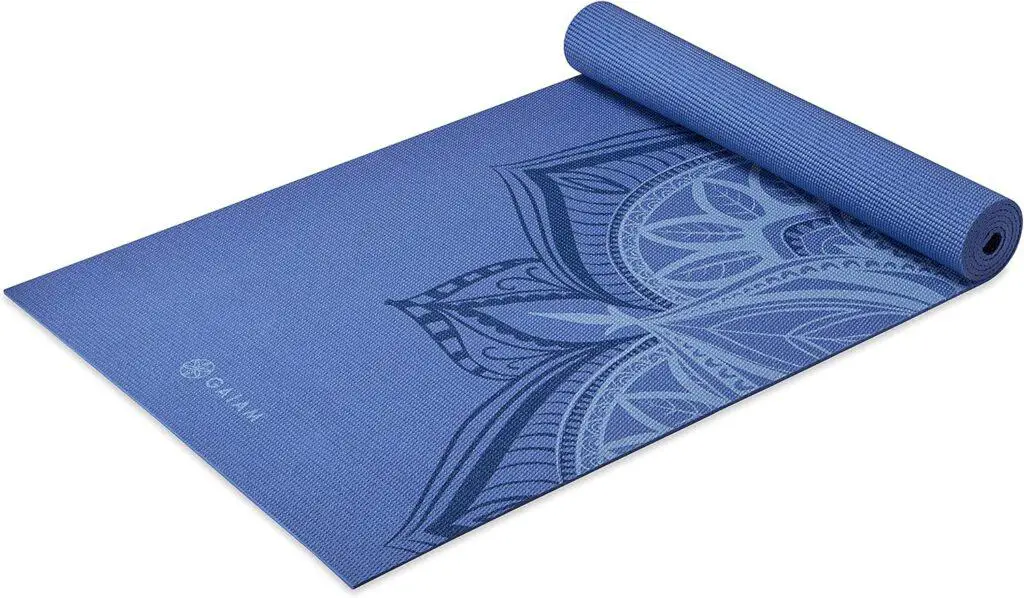
With the yoga equipment market now crowded with brands all promising exceptional grip, cushioning, and durability, it can be tricky to select the very best yoga mat company suited for you. While newcomers offer affordability, the standout veterans continue leading through innovation and quality manufacturing. Consider investing in a reputable yoga mat brand you can trust through countless hours of vigorous flow.
Manduka
This heritage brand stays at the forefront of high-performance yoga gear, especially its PRO line featuring supreme density to support years of consecutive practice without flattening. Their unique dot texture prevents sliding in sweat-dripping conditions making them a top choice for heated classes. Made from non-Amazon harvested natural tree rubber, Manduka mats represent sustainable quality.
JadeYoga
Dedicated yogis committed to an eco-friendly practice love JadeYoga’s extensive catalog of mats sustainably sourced from natural materials. The flagship Harmony yoga mat provides an unmatched grip with premium harvested rubber tapped straight from trees. The ultra-thin Travel Yoga Mat packs down tiny for jet-setting. Align your chakras with their new Chakra Print additions too featuring colorful cosmic imagery.
Gaiam
This widely recognized brand caters to all types of athletes across yoga, fitness, and meditation gear. Gaiam is the convenient go-to for basic starter mats under $25 as well as premium yoga towel/mat combinations made from antimicrobial microfiber. Their online shop also stocks popular bundle sets pairing a mat with complementary block or strap accessories.
Yogi Bare
The ultimate custom mat experience awaits with Yogi Bare offering create-your-own mat designs perfect for specialized gifting or studios wanting unique member merchandise. Using interactive online templates, customize everything from layered patterns to personalized names integrated into edgy mantras or floral motifs. Their high-quality TPE material outperforms standard mats on responsiveness, cushioning, and grip with no PVC.
Lululemon
While known foremost for their stylish yoga pants, Lululemon’s famous Reversible Mat marked an innovative breakthrough in studio gear. The smooth side provides minimal stick for slick floor flows while a quick flip reveals a grippy towel fabric securing grounded poses. With loads of colors now numbering over 100 mat releases, their three-year Vinyasa Collaboration special edition sells out instantly thanks to ultra fans.
Key Takeaways When Selecting a Yoga Mat
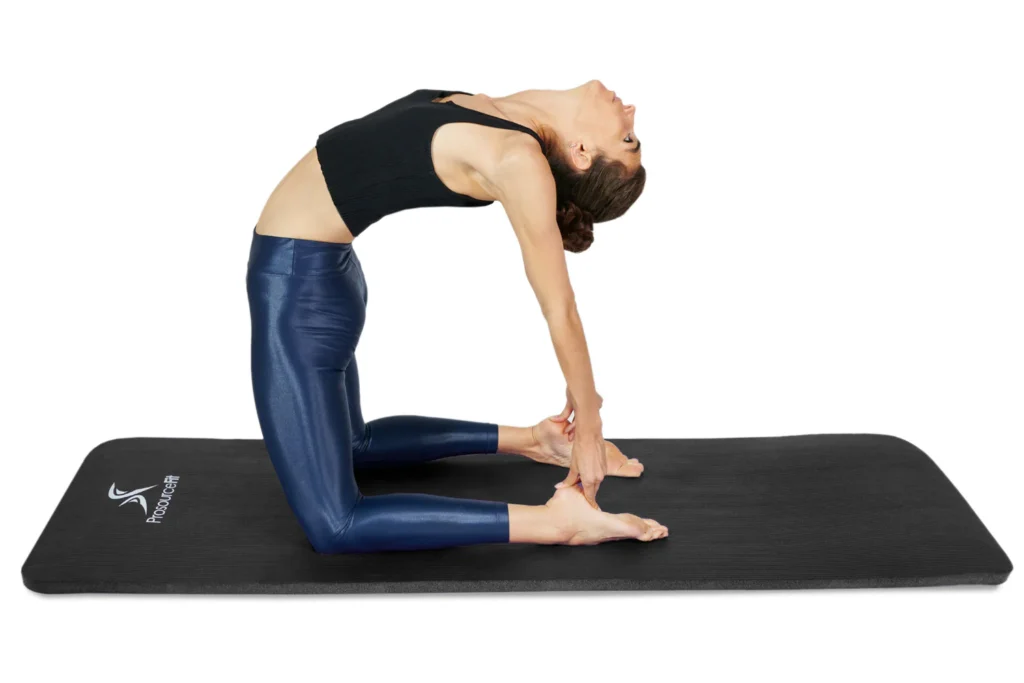
Sorting through the practical factors from thickness to eco-rating along with the style elements of color and print that speak you your personality can make choosing the ideal yoga mat overwhelming. Keep these essential tips in mind while navigating the options:
Special Care Tips for Your Yoga Mat:
Caring properly for your yoga mat ensures it provides years of reliable cushioning and traction as your practice evolves. Beyond regular cleaning rituals, consider these pro tips for maintaining the quality and performance of your mat over the long run:
Let Breathe & Deodorize
Since yoga mats are prone to retaining odors from sweat and feet over time, letting them breathe in fresh air routinely keeps smells at bay. Unroll your mat flat outside or open windows wide so airflow can whisk away trapped bacteria causing unpleasant funk. Turn occasionally and flip over to hit both sides. You can also sprinkle with baking soda before rolling up to safely absorb and neutralize stinky moisture inside.
Spot Scrub Immediately
Don’t ignore new stains settling into your mat’s surface thinking they’ll come out with your next overall washing. Apply spot stain remover right after class before stubborn oil, dirt, and grime fully oxidize on the micro level. Dish soap mixed with warm water can lift pigmented splotches when rubbed gently with a soft bristle brush. Rinse and dab dry with a towel before full drying.
Sanitize with Sun
Harness the natural power of UV rays to destroy the microorganisms that breed odor and stain-causing bacteria embedded deep in your yoga mat foam. Simply unroll your mat in direct sunlight and rotate occasionally to cover all sides across 2-3 hours for a deeper cleanse than any detergent could achieve. Don’t attempt with brightly dyed mats since sunlight also fades coloring slowly.
Anti-Static Spray
Standard yoga mat materials like PVC and rubber have a tendency to cling to hair, lint, and fuzz. Annoying debris picked up off your studio practice room carpet and then transferred back to your mat can be prevented by using anti-static spray. Designed to neutralize the charge on fabric and upholstery, anti-static helps repel annoying clingy particles to your gear keeping surfaces clear of cling. Reapply monthly for optimal results.
Balance Your Practice
While daily downward dog provides continuity across mind, body, and mat, excessive repetition also wears down your equipment unevenly over time by compressing the same high-impact areas repeatedly. Counter the effects through well-rounded additional activities like Pilates moves to engage alternative zones. Distribute pressure evenly by consciously transitioning to low-traffic spaces during flows. Slightly adjusting alignment prevents permanent compression lines.
Level Uneven Spots
Should you discover sagging valleys or lumpy zones despite diversifying routines, these compressed areas can be remedied using DIY yoga mat fillers. Thin household or grill spatulas make perfect edges for massaging and lifting indented sections gradually. Insert a washcloth layer for protective padding when aggressively working to smooth uneven foam. Take patience over weeks to rehabilitate dips through gentle persuasion.
Evaluate Warranty
With premium yoga mats ranging from $100+, make sure to assess the durability guarantees before purchasing, especially with excessive molting or flaking. Standard manufacturer defects are commonly covered within the first 60 days post-purchase. Material & workmanship flaws extending around 6 months or more provide peace of mind for larger investments into eco-friendly natural rubber mats spanning years.
Frequently Asked Questions:
Q: How thick should my yoga mat be?
A: Standard mat thickness is around 1/8 inch (3mm). If you have sensitive joints, a thicker 1/4 – 1/2 inch mat will provide more cushioning. Travel mats are thinner for easy transport.
Q: Are thicker mats better for yoga?
A: Thicker mats around 1/4 inch thick provide excellent padding to protect joints and bones during yoga poses. But they are less portable. Choose based on your needs.
Q: What size yoga mat should I get?
A: The average mat size is 24 x 68 inches (61 x 173 cm). Taller people over 5’8” may prefer extra-long mats up to 85” in length. Wide 26-28 inch mats allow plenty of space for hands/feet during balancing poses.
Q: Which yoga mat material is the best?
A: Natural rubber and PVC materials provide the best traction and cushioning. Recycled rubber and plant-based mats like TPE are popular eco-friendly options too. The best material depends on your personal preferences.
Q: Do I need a yoga mat just for hot yoga classes?
A: Special hot yoga mats made of moisture-wicking microfiber can improve grip and absorption. But you can use a standard sticky mat for hot classes too by placing a towel on top.
Q: How do I keep my yoga mat from sliding?
A: Applying a non-slip spray temporarily helps traction on slippery hardwood. Using a towel, yoga socks, or purchasing a sticky mat also helps prevent sliding during practice.
Q: Why does my yoga mat smell bad?
A: Bacteria and sweat absorbed into the mat foam cause odors over time. Clean monthly using antibacterial sprays/wipes and allow to fully air dry after practicing to prevent smells.
Q: Can I practice yoga without a mat?
A: You can practice barefoot on carpet or grass if you prefer. But using a mat helps grip, cushioning, alignment, and stability for more advanced poses.